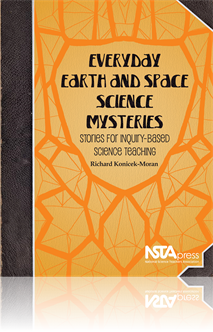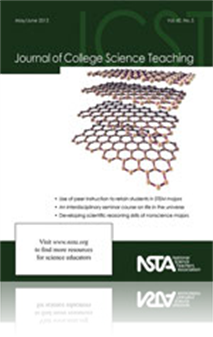All Resources
Book Chapter
5E(z) Guidelines for Designing Research- Informed Science Lesson Sequences
Overworked elementary teachers do not have to invest their limited time in creating, field-testing, and revising their own science activities from scratch. This chapter reviews the five steps that teachers can use to better sequence science learning ...
Book Chapter
What is wind? What is it made of? What can it do? In this lesson, students explore ways to change the speed and direction of a Ping-Pong ball using a handheld air pump to simulate wind. Simple experiments help them understand that air has weight and ...
Class Pack
*LAST CHANCE! This product is not eligible for return or exchange. All sales are final.* ...
Book Chapter
What’s Hiding in the Woodpile?
Wood comes from trees, right? It is full of potential chemical energy that can produce heat when it is put into a stove or fireplace and burned. Yet, in this story, the Earth’s bounty seems to produce a cooler room. What can be the cause? Thermodyn...
eBook
Science for the Next Generation: Preparing for the New Standards (e-book)
“The old models of teaching as simply telling, and learning as passive sit-and-get listening, will not meet the needs of tomorrow’s citizens.” —Thomas O’Brien in the Overview to Science for the Next Generation Preparing for tomorrow is...
NSTA Press Book
Science for the Next Generation: Preparing for the New Standards
“The old models of teaching as simply telling, and learning as passive sit-and-get listening, will not meet the needs of tomorrow’s citizens.” —Thomas O’Brien in the Overview to Science for the Next Generation Preparing for tomorrow is ...
Class Pack
In this lesson, students make observations of sunrise and sunset and learn that they are caused by Earth’s rotation. They also learn about the effect of Earth’s rotation on length and direction of shadows as well as the illusion that the Sun and ...
NSTA Press Book
Even More Picture-Perfect Science Lessons: Using Children’s Books to Guide Inquiry, K–5
Winner of the Gold EXCEL Award from Association Media & Publishing!“The number one compliment we hear from teachers is that the lessons are complete and ready to take back to their classrooms and use.” —Emily Morgan and Karen Ansberry, coautho...
By Emily Morgan, Karen Ansberry
eBook
Even More Picture-Perfect Science Lessons: Using Children’s Books to Guide Inquiry, K–5 (e-book)
Winner of the Gold EXCEL Award from Association Media & Publishing!“The number one compliment we hear from teachers is that the lessons are complete and ready to take back to their classrooms and use.” —Emily Morgan and Karen Ansberry, coautho...
Journal Article
Case Study: Case Studies and the Flipped Classroom
This column provides original articles on innovations in case study teaching, assessment of the method, as well as case studies with teaching notes. This month’s issue discusses the positive and negative aspects of the flipped classroom....
Journal Article
This study was conducted in a chemistry course for nonscience majors offered as part of a liberal education core curriculum at a large public university. Students enrolled in the class were given the Lawson Classroom Test of Scientific Reasoning as a...
Journal Article
A Case Study: Using Authentic Scientific Data for Teaching and Learning of Ecology
This article describes a culminating assignment for students enrolled in a human ecology course in a Masters in Science Eduation program. The goal of this assignment was for students to use published scientific data to link daily life, human impact, ...
Journal Article
The authors designed a physics course for prospective elementary and middle school teachers to foster aspects of scientific thinking recommended in reform documents. Because the elementary school curriculum focuses heavily on literacy, they also expl...
Journal Article
A tight coupling of systems theory and service learning provides learners with the knowledge and skills required to tackle contemporary social-environmental challenges. The tangible benefits of a systems theory–service learning curriculum occur in ...
Journal Article
Point of View: The Color of Blood
This column shares reflections or thoughtful opinions on issues of broad interest to the community. This month’s issue discusses teacher and student misconceptions related to blood and other science information....
Journal Article
This study explores students' self-perceptions across science subjects by gender and underrepresented minority group membership....
Journal Article
Two-Year Community: Life in the Universe: An Interdisciplinary Seminar Course
This article describes highlights of a community college's 15-week interdisciplinary seminar course, Life in the Universe, including students' perceptions of the course elements....
Journal Article
Using Learning Preferences to Direct Teaching and Balance Academic Performance
The author uses the Index of Learning Styles in his Introductory Biology class and finds a link between academic performance in the laboratory and learning preference scores....
Journal Article
A Course That Prepares Science Graduate Students to Publish
This article addresses key questions about a course that prepares graduate students in the sciences to publish research in a timely fashion, grounding them in the processes of academic publishing....
Journal Article
Retaining Students in Science, Technology, Engineering, and Mathematics (STEM) Majors
This article presents results relating undergraduate student retention in STEM majors to the use of Peer Instruction (PI) in an introductory physics course at a highly selective research institution. The authors compare the percentages of students wh...
Book Chapter
This story is based upon using solar energy and a variety of materials to modify and channel this energy to capture and hold heat. Almost everybody has experienced the differences in temperature due to sunshine passing through windows into an enclose...
Book Chapter
Some students may not believe that it is possible for a puddle that appears larger to evaporate more quickly than one that seems smaller. The story in this chapter has to do with evaporation. The authors explore the major factors that lead to how qui...
Book Chapter
The main purpose of the “Cheeks” story is to get the children to learn something about the behavior of shadows cast by objects in sunlight. Although the story takes liberties with the “thoughts and projections” of Cheeks, one can take it as m...









